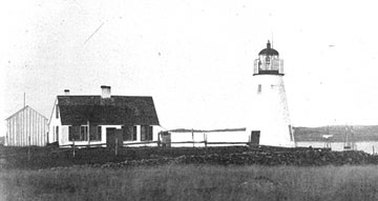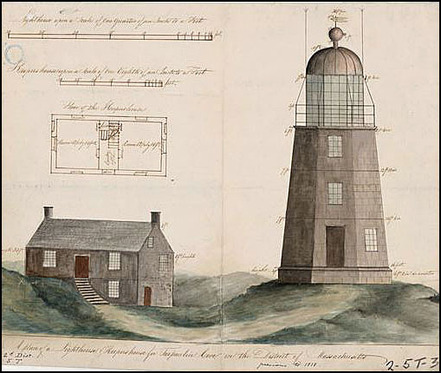History of Tarpaulin Cove Light, Gosnold, Massachusetts
© Jeremy D'Entremont. Do not reproduce any part of this website without permission of the author.
Naushon Island, about seven miles long and 5,000 acres in area, is the largest of the Elizabeth Islands, a chain of 16 islands that extend about 16 miles westward into Buzzards Bay from Falmouth on Cape Cod.

The first Tarpaulin Cove Lighthouse, U.S. Coast Guard photo
Naushon Island's name comes from the local Indians' name for the entire chain, "Nashanow," thought to mean "midway islands," referring to the islands' position separating Vineyard Sound and Buzzards Bay.
Naushon was long used for the pasturing of livestock, with; there were as many as 2,000 sheep on the island in the early nineteenth century. Tarpaulin Cove, on the east shore of the island, was for many years a bustling little place where the local farmers did business with the crews of incoming vessels.
Seamen traveling through Vineyard Sound often stopped for a meal or a night's stay at a tavern run for many years in by Zaccheus Lumbert. Lumbert established an early navigational light in 1759, for the "public good of Whalemen & Coasters." Lumbert and his successors maintained the light for nearly six decades.
Naushon was long used for the pasturing of livestock, with; there were as many as 2,000 sheep on the island in the early nineteenth century. Tarpaulin Cove, on the east shore of the island, was for many years a bustling little place where the local farmers did business with the crews of incoming vessels.
Seamen traveling through Vineyard Sound often stopped for a meal or a night's stay at a tavern run for many years in by Zaccheus Lumbert. Lumbert established an early navigational light in 1759, for the "public good of Whalemen & Coasters." Lumbert and his successors maintained the light for nearly six decades.
The waters of Vineyard Sound were among the busiest in the world in the early 1800s.

Illustration of the first (1817) lighthouse at Tarpaulin Cove. National Archives.
The first government appropriation for a proper lighthouse at Tarpaulin Cove was made in 1807, but no action was taken for another decade. The federal government paid $216 for suitable property for the establishment of a lighthouse on the west side of Tarpaulin Cove in 1817.
A rubblestone tower -- described as 38 feet tall in some sources, but reported as 25 feet tall in Lt. Edward W. Carpender's 1838 inspection -- was built for a little over $6,000. It went into service in October 1817, exhibiting a fixed white light 71 feet above the water. John Hayden was the first keeper of the light and remained at Tarpaulin Cove for at least 25 years.
Hayden's statement for engineer I. W. P. Lewis's 1843 survey painted a dire picture:
The tower is leaky from top to bottom, so that I have to cut the ice off the staircase in winter. All the staircase and window frames are more or less rotten -- the landing of the stairs dangerous to tread upon. The lantern sweats so as to make quantities of ice on the glass and floor. The tower is not high enough to clear the land to the westward, so that the light in that direction is of no use to vessels near the shore. The dwelling-house leaks badly about the windows, the frames of which are rotten; cellar stairs rotten, and ridge boards of the roof old and rotten. . . . There is a boat-house and landing; the landing is a kind of trestle bridge made of rough poles, and is nearly knocked to pieces in the surf. . . .
I consider the establishment was not faithfully built in the first instance. The plastering is more or less fallen off in the chambers and sides of the other rooms; chimneys are all smoky, and the house cold and uncomfortable.
A rubblestone tower -- described as 38 feet tall in some sources, but reported as 25 feet tall in Lt. Edward W. Carpender's 1838 inspection -- was built for a little over $6,000. It went into service in October 1817, exhibiting a fixed white light 71 feet above the water. John Hayden was the first keeper of the light and remained at Tarpaulin Cove for at least 25 years.
Hayden's statement for engineer I. W. P. Lewis's 1843 survey painted a dire picture:
The tower is leaky from top to bottom, so that I have to cut the ice off the staircase in winter. All the staircase and window frames are more or less rotten -- the landing of the stairs dangerous to tread upon. The lantern sweats so as to make quantities of ice on the glass and floor. The tower is not high enough to clear the land to the westward, so that the light in that direction is of no use to vessels near the shore. The dwelling-house leaks badly about the windows, the frames of which are rotten; cellar stairs rotten, and ridge boards of the roof old and rotten. . . . There is a boat-house and landing; the landing is a kind of trestle bridge made of rough poles, and is nearly knocked to pieces in the surf. . . .
I consider the establishment was not faithfully built in the first instance. The plastering is more or less fallen off in the chambers and sides of the other rooms; chimneys are all smoky, and the house cold and uncomfortable.
Lewis recommended a new tower, reporting the "whole establishment in a dilapidated state."

The present Tarpaulin Cove Light in the late 19th century
An 1850 inspection praised Hayden and indicated that repairs had improved life at the station somewhat.
Light-house is in good order. Some repairs to the work to the dwelling have been made since I supplied last year, such as a new outside cellar door; and lighting apparatus is in good order and clean; and, in fact, so is the whole establishment. Keeper is a hard-working, likely man, and has brought up a large family.
A fifth-order Fresnel lens from L. Sautter and Company of Paris was installed in 1856. In April 1870, the characteristic was changed from a fixed white light to fixed white punctuated by brighter flashes every 30 seconds.
Light-house is in good order. Some repairs to the work to the dwelling have been made since I supplied last year, such as a new outside cellar door; and lighting apparatus is in good order and clean; and, in fact, so is the whole establishment. Keeper is a hard-working, likely man, and has brought up a large family.
A fifth-order Fresnel lens from L. Sautter and Company of Paris was installed in 1856. In April 1870, the characteristic was changed from a fixed white light to fixed white punctuated by brighter flashes every 30 seconds.
In 1888, the old stone house was replaced, and in 1891 a new, 38-foot brick lighthouse tower was built, with an iron lantern and a fourth-order Fresnel lens.

Only the lighthouse tower remains standing today
A 1,200-pound fog bell in a tower with striking machinery was installed. The bell tower was destroyed in the great hurricane of September 21, 1938.
Frank Davis was keeper in the 1920s. On one occasion a schooner called the Tanzy Bitters caught fire. Davis rescued two badly burned men and brought them into the kitchen of the keeper's house. His wife did her best to treat the men while Davis went to Martha's Vineyard to get a doctor. The men died, but the doctor said he couldn't have done more than Mrs. Davis had. While her husband was away, Mrs. Davis also tended the light.
After the light was automated in 1941, the house and other buildings fell into disrepair and were torn down in 1962. The lighthouse is now maintained by the Cuttyhunk Historical Society. The area around the cove is also home to a herd of belted Galloway cows, who sometimes like to take a dip in the ocean.
Frank Davis was keeper in the 1920s. On one occasion a schooner called the Tanzy Bitters caught fire. Davis rescued two badly burned men and brought them into the kitchen of the keeper's house. His wife did her best to treat the men while Davis went to Martha's Vineyard to get a doctor. The men died, but the doctor said he couldn't have done more than Mrs. Davis had. While her husband was away, Mrs. Davis also tended the light.
After the light was automated in 1941, the house and other buildings fell into disrepair and were torn down in 1962. The lighthouse is now maintained by the Cuttyhunk Historical Society. The area around the cove is also home to a herd of belted Galloway cows, who sometimes like to take a dip in the ocean.
Use this player to hear a podcast interview about Tarpaulin Cove Lighthouse with Paul Elias, longtime summer resident and a trustee of Naushon Island:
Keepers: (This list is a work in progress. If you have any information on the keepers of this lighthouse, I'd love to hear from you. You can email me at [email protected]. Anyone copying this list onto another web site does so at their own risk, as the list is always subject to updates and corrections.)
Zaccheus Lumbert (1759-1764); various Cove Tavern keepers (1764-1817); John Geyer (1818-1852); Joseph R. Luce (1852-1853); Nathan Clifford, Jr. (1853-1861); Abraham C. White (1861-1864) Samuel E. Skiff (1864-1869); William E. Skiff (1869-1871); Richard Norton (1871-1882); Calvin N. Adams (1882-1886); Frank S. Carson (1886-1910); George T. Gustavus (1910-?); George A. Howard (1910-1912); Frederick W. Field (1912-1916); Carl Delano Hill (1916-1920); Frank Allen Davis (1920-1928); Tolman Spencer (1928-1941).